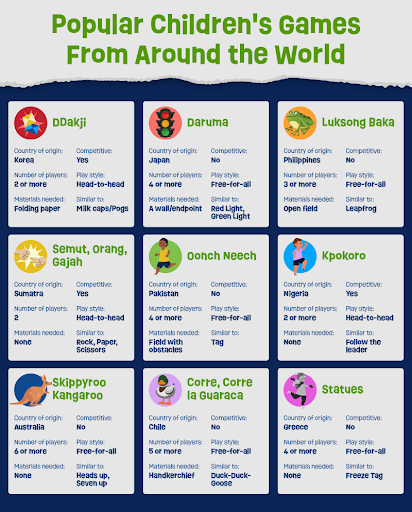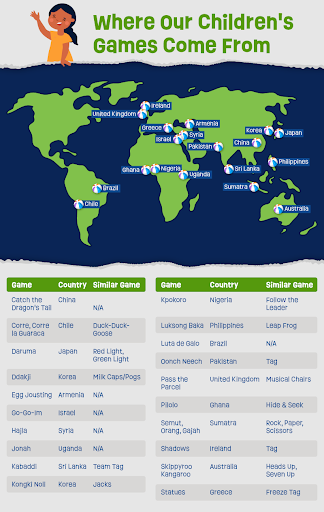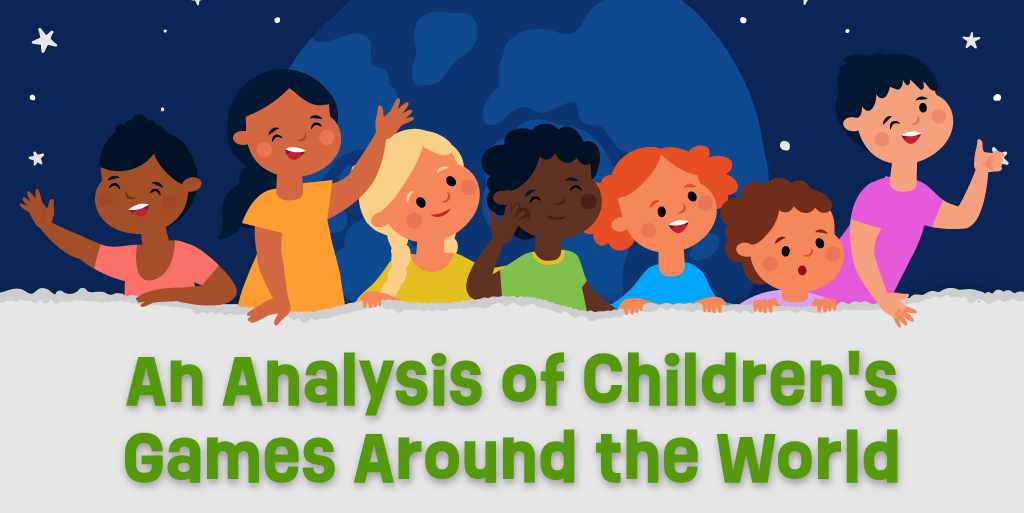Admit it, in elementary school, your favorite part of the day was recess. At Bits And Pieces, we’re right there with you. There’s nothing like sneakily walking across crunchy mulch, trying to be quiet during Hide-and-seek, or holding your breath full of anticipation while playing Red Light, Green Light on the blacktop.
Thinking back on some of our favorite playground games growing up, like Tag and Duck-duck-goose, got us wondering: what do children’s games from other countries look like? Netflix’s Squid Game introduced people, in an interesting way, to some of the popular children’s games played in Korea but we wanted to take it a few steps further and have a closer look at children’s games played outside of the United States.
Methodology
Our goal was to collect information about popular playground games enjoyed by children around the world and get a better understanding of how they compare to those we are more familiar with here in the U.S. To conduct our analysis, we looked at playground games from five different continents and took several different factors into account: country of origin, number of players, needed materials, competitiveness, play style, played indoors or outdoors, and if there’s any similar game in the U.S.
Since we knew you would certainly want to try a few of these out for yourself, we also included brief descriptions on how to play. Interested in learning more games for kids to play from around the world? Read on!
Popular Children’s Games Played Around the World

Playing traditional playground games from around the world is a great way to introduce children to different cultures while having some fun doing it. For example, children in Greece celebrate their country’s artistic history by playing a version of tag called Statues and in Korea children play a game called Ddakji that incorporates paper folding, an important part of Korean culture. Now, let’s have a closer look at some of these popular playground games.
First introduced to many in Netflix’s popular series Squid Game, Ddakji is a traditional children’s game played in Korea. The fun of this game starts before it begins because players have to create their own ddakji by folding paper into a specific shape. The game starts with one player laying one of their ddakji flat on the ground. The objective is to throw your ddakji at the other and flip it over. Each player takes turns doing this until the ddakji flips over. Traditionally, whichever player made the ddakji flip then gets to keep it.
Daruma is another playground game that many Americans were first exposed to in Netflix’s original drama, Squid Game. The rules to Daruma are very similar to one of our favorites, Red Light, Green Light, but with a couple of twists. When players are caught moving, they must go and hold hands with the player who is “It.” If someone reaches “It” without being caught, they slap “It” on the back and the players who were previously out have to run away. Then “It” yells STOP and everyone must freeze. If “It” can reach you within three steps, then that player becomes “It” for the next round.
Semut, Orang, Gajah is the Sumatran version of the well-known American game Rock, Paper, Scissors and is played in nearly the exact same way. The only difference is the hand gestures each player throws out. When you play Semut, Orang, Gajah, your options are your pinky finger (ant), your index finger (man), or your thumb (elephant). Man beats ant, elephant beats man, ant beats elephant. Semut = ant, Orang = man, Gajah = elephant. Look at that, now you know a few more Indonesian words!
Another fresh take on what we would call tag, Oonch Neech (loosely translating to Above, Below) is a free-for-all game played by children in Pakistan. Before the game begins, one player is selected to be “It,” and chooses either oonch (above) or neech (below). If oonch is chosen, then players are only safe when they are on the ground, if neech is chosen, players only safe when they are up on top of something Iike a stump, bench, or piece of playground equipment. The first person tagged in the run of play becomes “It” for the next round.
In Nigeria, children play a form of Follow the Leader called Kpokoro that also includes elements of clapping games you might be more familiar with, like Patty Cake. This is a head-to-head game where players face each other and clap their hands together to the rhythm of clap, pause, clap, pause, clap-clap-clap, pause. On the final pause, both the leader and the challenger kick out one of their legs. If the challenger’s leg mirrors the leg the leader kicks out in two out of three rounds, then they take the place of the leader, if they don’t they go to the back of the line. The game is typically played with many players in a horseshoe formation, to keep track of which player is up next. The game ends when one player faces every other player without losing.
If you spend enough time in Greece, you may come across a group of children playing Statues, which is sort of like a different version of freeze tag with one major rule change. In this free-for-all playground game, one player, “It,” closes their eyes and counts to at least 10 while the other players run around to try and get away from them. Once “It” stops counting every other player must freeze where they are and take the form of a famous statue, like the Thinker or Discobolus. The objective of the game is for “It” to make the other players break their statue-like poses. The last player to remain frozen without moving is the winner.
While there are important nuances in each of these games that make them unique, there are more similarities than differences to some of the games children in the United States play. This serves as a good reminder that while each culture has its own customs and traditions, there are more ties that bind us than walls that separate us.
Where These Children’s Games Come From
While we have already taken a closer look at several children’s games from different parts of the world that have similarities to some of our favorites, others like Catch the Dragon’s Tail (China), Jonah (Uganda), and Luta de Galo (Brazil), are quite unique and you can learn more about them below.
Catch the Dragon’s Tail is a traditional Chinese playground game where the more players, the merrier. You want to gather at least 10 people and form a line with their hands on each other’s shoulders. The front of the line is the dragon’s head, while the caboose is the dragon’s tail. The goal is for the head of the dragon to catch its tail, so the head must strategically maneuver the line around to tag the last player. The middle players attempt to stop the head. When the head finally catches the tail, the player last in line takes the front position, becoming the new dragon’s head.
Uganda’s game, Jonah, transports you into a rowboat. With five or more people, sit in a ‘V’ shape, then sway forward and backward as if you’re rowing through turbulent waters while singing a rhyme about Jonah. When the song ends, imagine your boat has entered the eye of the storm. Players begin to sway from left to right. The pace of the swaying gets faster and faster until players lose their balance and fall to the side—those who do are out!
In the Brazilian game Luta de Galo, all you will need is 2 players, enough room, and two bandanas. And though “luta de galo” means “fight of the roosters” in Portuguese, the fun game doesn’t involve fighting at all. Both players tuck the bandana in their back waistband or back pocket—a little tail. Once bandanas are secure, players must cross their arms across their chest and lift their left leg. On the count of three, each person hops around on one leg to grab their opponent’s bandana with their free arm. The first to grab the other bandana without letting your foot down or unfolding their right arm wins.
If you’re interested in learning how to play some of the other games on our map, then have a look at our complete table of children’s games from around the world below!
More Children’s Games and How To Play
Closing Thoughts
So, are you ready to play? At Bits And Pieces, we value tradition and understand how to have fun. That’s why, after you’ve grabbed your friends or loved ones to explore these playground games from around the world, we have a variety of fun and interesting toys and games that will keep you playing all day long.

